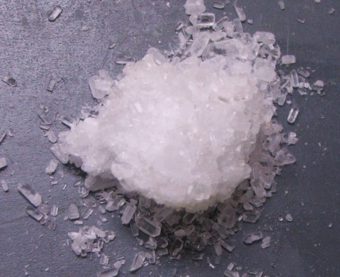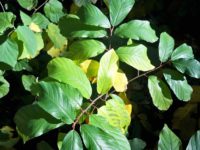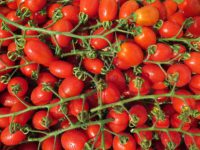Name of Product: Westland Epsom Salts
The Best Place to Buy: www.amazon.co.uk
Product Dimensions: 24cm x 14.2cm x 7.2cm.
Shipping Weight: 1.5kg
My Score: 8/10
In this article, we will be discussing the important role that sulphate of magnesium or Epsom salts, as it is alternatively known, plays in the garden. You are probably aware of the use of Epsom salts in baths, where they help when you are having a relaxing bath. This compound if rightly used has a multitude of uses in the garden and container garden.
In a previous article, I mentioned that chlorosis of leaves can be due to a problem with the absorption of iron, but another deficiency can cause the leaves to yellow.

Epsom salts or magnesium sulphate has the chemical formula MgSO4 and has 2 important elements-magnesium and sulphur.
Magnesium is an important element on the formation of chlorophyll and therefore has importance in helping photosynthesis. A deficiency of this important element is unusual as it is already found present in the soil. If you notice leaves starting to turn yellow between the veins, then you have a magnesium deficiency.
YOU ALSO GET SULPHUR PROVIDED
Sulphur, on the other hand, also aids in the formation of chlorophyll, in roots growth and how vigorous the plant grows too. It also determines how hardy the plant is. Again, it is normally found in the soil already present. A deficiency in this important element will result in yellowing of leaves and new grown will be weak and spindly.
Iron deficiency normally has yellowing at the edge of the leaves so do note the difference between the deficiencies of all three elements. As you may be treating an iron deficiency but instead you have a magnesium deficiency instead.
Consult my article of elements in the container to note the difference in deficiency between the three elements.
WHAT IS EPSOM SALT?
Epsom salt or magnesium sulphate to give its IUPAC name, is a naturally occurring compound that has a multitude of uses in both the home and in the garden. As said earlier, it provides two essential elements that can be in short supply in the garden.
Epsom salt supplement has a large amount of magnesium oxide in it, around 16.5%, which is equivalent to a magnesium content of 10%.

What must be remembered that this supplement cannot be used willy-nilly all over the garden, as in the long run, this can cause more problems than it solves. As said in the beginning, magnesium deficiencies are not common but can happen in the container garden more. So, if you recognise a deficiency in the plant due to deficiency of magnesium, then Epsom salts can be used to correct it.
WHAT USES DOES EPSOM SALTS HAVE IN THE GARDEN?
Magnesium sulphate is believed to have a role in increasing the uptake of nitrogen, phosphorous, potassium and other trace elements. A plant that is given one tablespoon per 4.5 litres of water, twice a month has thicker foliage and better blooms.
DEALING WITH TRANSPLANT SHOCK
One problematic aspect of gardening is transplanting shock, where a plant will sulk and wilt once it is moved from its present location.
It has been found that if you add one or two teaspoons of Epsom salts directly to the hole before transplanting a plant, shock can be minimised. The soil needs to be backfilled, firmed and then watered afterwards. So the plant settles in well.
DETERING PESTS
To deter pests, to stop pests eyeing your plants, you can mix one tablespoon of the supplement with 4.5 litres of water and then apply it as a foliar feed. If you want to deter slug and snails, the rough texture of the crystals should deter them from your plant. Just sprinkle some on top at regular intervals near the plant.
ADDRESS A DEFICIENCY
The main use of Epsom salt is to address a magnesium deficiency, where mature leaves start turning yellow and curling. You can add vibrancy to the green leaves by using it as a foliar feed. To do this mix 35g of Epsom salts with 4.5 litres of water, and then fill a sprayer bottle with the resulting solution and use to spritz around the plants. It is better this way than use it directly in the ground, which can still be done by adding the mixture directly to the plant.

Every month during the growing season, if you water an Epsom salt solution liberally to the root of fruit trees and soft fruits then the flavour can be improved. Sweet pepper and tomatoes can be improved in flavour if you add 2 tablespoons of Epsom salts in each planting hole and then apply once a week when it is actively growing.
If you add Epsom salts to new and established rose bushes, along with nitrogen, phosphorous and potassium, you will get vibrant leaves and colourful blooms. Before planting a new rose bush, add one tablespoon of Epsom salt to the bottom of each planting hole. For established roses, use a foliar feed once in spring and once gain during flowering.
HOW TO USE
- As a sprinkle around plants use 35 grams, a handful per square metre is sufficient.
- As a foliar feed, 35g per 4.5 litres of water and then spray directly on the leaves.
PROS
- Have multiple uses in the garden.
- Relatively cheap
- Can be used as a dry, granular feed or a foliar feed.
- Is relatively harmless as long as you do not consume the product. There is garden grade and there is pharmaceutical grade. Do not waste using pharmaceutical l grade in the garden; it is too expensive.
CONS
- It is not required if a deficiency is not noticed.
- It forms a solid lump when it gets wet, which is difficult to break up.
WHY WOULD YOU USE EPSOM SALTS IN THE GARDEN?
If you want plants that are greener than others then you cannot go wrong with Epsom salts. You can use it for many plants from primulas, cabbage, roses, cotoneaster, laurels, fruit trees and bulbs. If the plant you grow is developing yellow leaves and not in acid-loving then you cannot go wrong with Epsom salt. My roses love it, so should you?
If you want to buy this product, you can find it here.
If you have any questions or comments that you wish to make, please do so in the comment box below.
Relax in the bath with Epsom salts whilst you think about feeding the garden with the same compound.


Here in Florida we cannot use any sort of weed and feed on lawns or in soils. My dad was the one that actually told me to use Epson Salt just the other day! So coincidentally I decided to look it up to see if he knew what he was talking about LOL I looked in the local WalMart and all they have is the small bag you would normally buy for use in the bathtub. Is this amount sufficient to be used for my plants, bushes and even the grass? Would a spreader work for this?
Hi Leah
I would not recommend those used for baths in the garden, as often they have extra ingredients in them that are not suitable in the garden. If you want to use Epsom salts it is better to get one specifically designed for gardens. and hence why this review was written. You can use spreaders but often you only need a small quantity and that’s why it is better to spread by hand.
I would not use it on the lawn as it will not work, as you do not want to feed your weeds. It is better to use a weedkiller specifically designed for lawns.
Kind Regards
Antonio
Thanks for your very informative posting about the uses of Epsom Salt in gardening. I had no idea it was so versatile. Clearly there are several benefits: improved nutrient uptake, reduced shock of transplanting and even discouraging pests such as slugs. This will be very useful advice for when I start gardening or raising transplants.
Hi David
It is really an eye-opener to what Epsom salts can do on the garden but it is important not to go overboard as it is only necessary where a deficiency is noted. It is such a great leave greener that you wonder what you did without it.
Thanks for stopping by and commenting.
Antonio
Getting enough energy and magnesium for the plants cannot be stressed enough and that is the more reason why we need this sulphate of magnesium that this Epsom salt actually provides for the plants and can really be helpful over the long time and to ensure that the plants are very healthy too. Thank you so much for sharing this post with us out here,I really appreciate you here
Hi Abel. It is very important that gardeners address any magnesium deficiency but most gardeners do not know what to do, They do now, as sulphate of magnesium has many uses in the garden apart from introducing magnesium. I always try to be as informative as possible. when I write my articles.
Thanks
Antonio